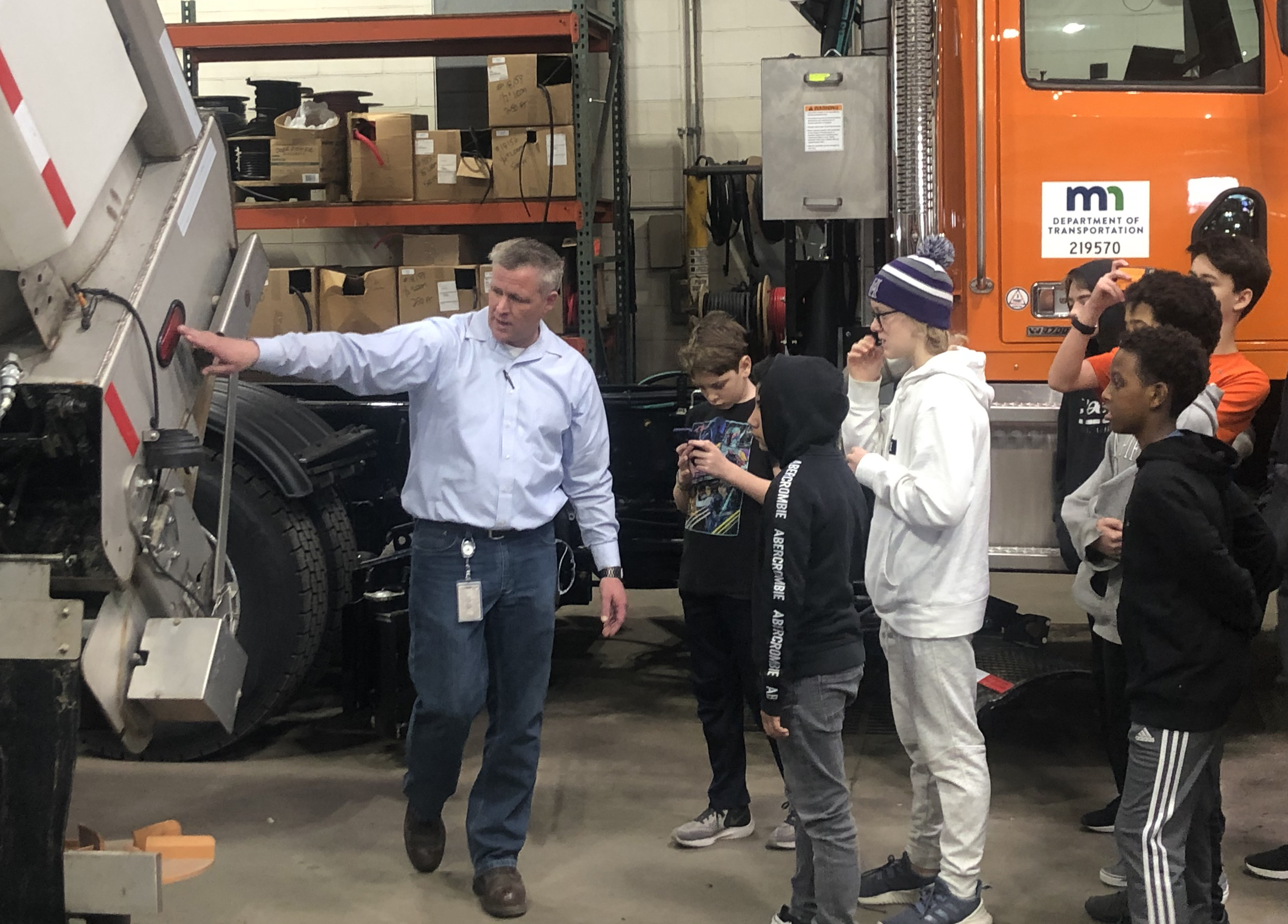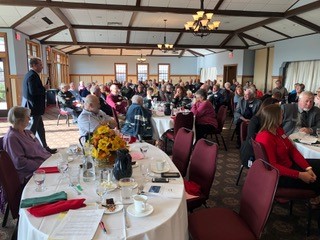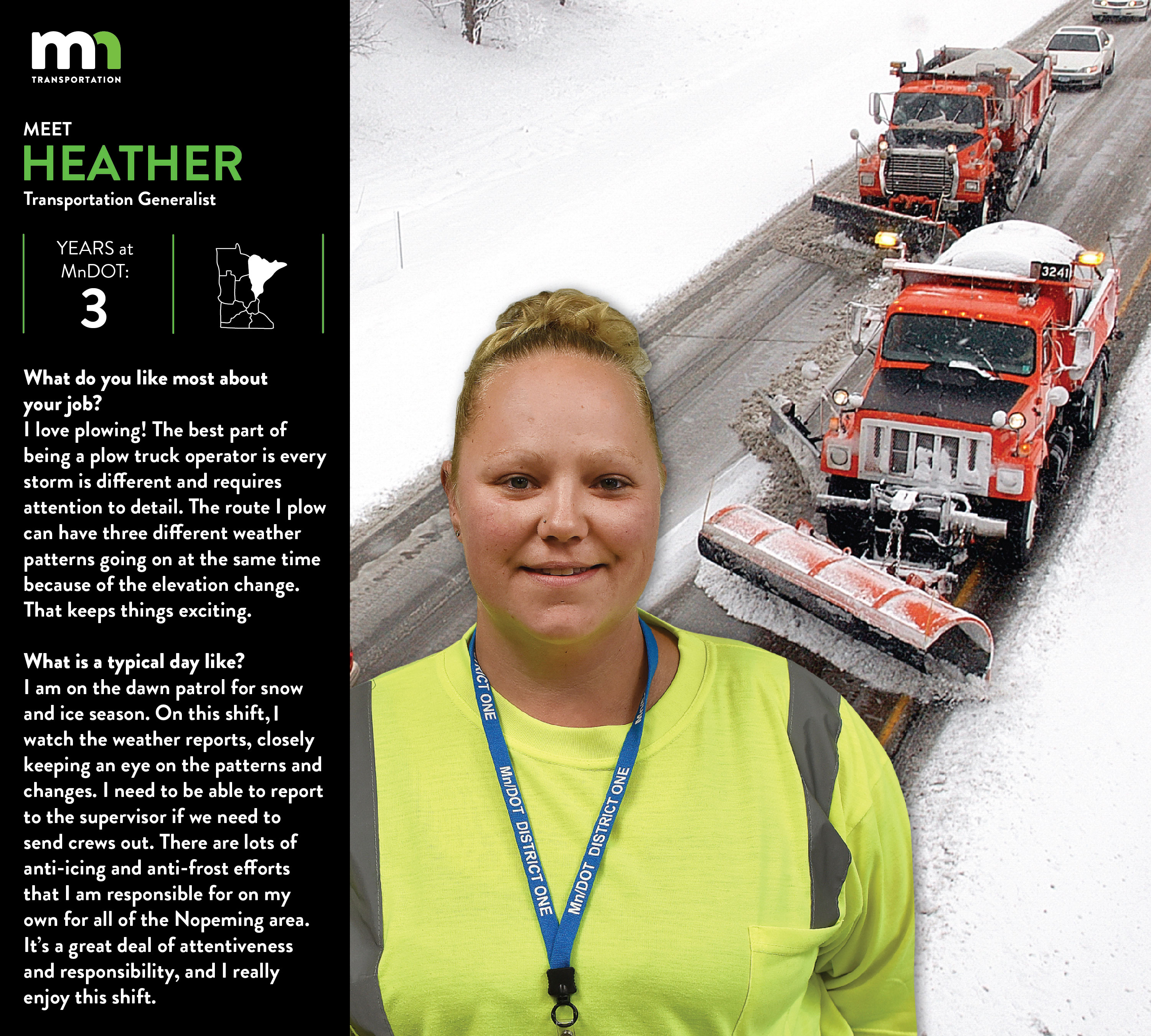 |
|

|
 |
TABLE of CONTENTS
|
Crews remove old Red Wing Bridge center span as part of demolition |
By Mike Dougherty, District 6 Public Engagement and Communications

Crews cut the plates to release the 800,000-pound center span of the Red Wing Bridge as part of demolition Feb. 6. Once freed, the span was lowered onto barges. Photo by Rich Kemp |
Sixty years after crews hoisted the Red Wing Bridge’s center span into place, workers were back at the site Feb. 6 to lower it onto barges as part of the old Mississippi River bridge’s demolition.
The 288-foot-long span was lowered by a series of four hydraulic industrial jacks atop the bridge that inched the steel downward approximately 15 feet per hour. Shortly after 8 a.m., demolition crews cut the steel joints in three corners. The cables in the jacks were then tensioned to hold the span in place for the final corner cut, which occurred shortly before noon.

The 288-foot-long center span was lowered by a series of four hydraulic industrial jacks atop the bridge that inched the steel downward approximately 15 feet per hour. Photo by Rich Kemp |
Getting to that point took months of discussions and analysis. The contractor, Zenith Tech Inc., of Waukesha, Wis., hired a consultant to design the plan and procedures for the lowering of the span. The plan was then reviewed by the project team, including the MnDOT Bridge Office and its consultant, Parsons.
“At each stage of this project, there needs to be significant planning, review and analysis before we proceed, which has kept safety as the top priority,” said Mark Anderson, MnDOT project manager for the Red Wing Bridge.
By late afternoon, the center span was resting on barges in the river and being ferried to the Wisconsin shore, where crews began cutting it into pieces that fit into a dumpster for recycling. Eight more spans are due to come down by March 13, the target to meet the possible start of the Mississippi River freight navigation season. By then, approximately 3.8 million pounds of steel will have been cut and carted away.
MnDOT’s team has been working with the community and the contractor throughout this process to ensure that the Goodhue County Historical Society receives a piece for its museum in Red Wing. Smaller mementos have been arranged with the contractor to ensure that community retains pieces of its past.
Completion of the $63.4 million construction project is scheduled for August. A community-wide celebration is planned for September. Last year, on Nov. 21 community members from Minnesota and Wisconsin gathered on the new bridge in advance of the start of traffic. A parade of first responders and veterans from both sides of the river processed along the bridge from Wisconsin into Minnesota to mark the event and reflect its new name that was approved by the Minnesota Legislature in 2019: the Eisenhower Bridge of Valor.
The Hwy 63 bridge construction project includes building a new bridge to replace the Hwy 63 bridge, replacing the slip ramp over Hwy 61, reconstructing approach roadways in Minnesota and Wisconsin, improving access to Red Wing and upgrading pedestrian and bicyclist crossings.
|
 |
|

|
 |
TABLE of CONTENTS
|
MnDOT partners with Blue Earth County to dismantle historic Kern Bridge |
By Joseph Palmersheim
Built in 1873, the Kern Bridge just southwest of Mankato has survived 145 Minnesota winters and spring floods. MnDOT partnered with Blue Earth County Feb. 6 to carefully dismantle the bridge and prepare it for storage.
The 189-foot-bridge is significant for being the only example of a “bowstring through truss bridge,” a popular bridge type from the 1850s to the 1880s. Typically constructed of cast or wrought iron, these bridge types marked the transition from wood, stone and timber building materials to metal. There are few bowstring arch bridges still standing in the Midwest or the United States.
The bridge will likely be reused for a bike and pedestrian crossing at a new location. MnDOT will be soliciting interested agencies to find a new home for the Kern Bridge. Federal Highway Administration funds are available to cover 80 percent with state or local match of 20 percent required. Contact Lisa Bigham and Katie Haun Schuring for more information.
|
 |
|

|
 |
TABLE of CONTENTS
|
Middle school students tour Central Shop, RTMC |
By Anne Meyer

James Grebenc, snowplow fabrication manager, shows Justice Page Middle School students various features of a snowplow during a recent tour of the Central Shop in St. Paul. Photo by Anne Meyer
|
With cellphones in hand, more than a dozen Justice Page Middle School students lined up to take their photo behind the wheel of a MnDOT snowplow Friday, Feb. 7, at the Central Service Facility in St. Paul.
Later in the day, the same group stood as close as they could to the glass perch overlooking dozens of television screens showing live views of various Twin Cities metro highways at the command center of the Regional Transportation Management Center in Roseville. And maybe, thanks to these experiences, one of these young minds will work for MnDOT someday.
The recent tour is part of the STEM outreach contract for the Interstate 35W at Interstate 94 Downtown to Crosstown project. STEM stands for “science, technology, engineering and mathematics.” MnDOT builds STEM tasks into larger projects to help build and inspire a future workforce.
“Integrating STEM outreach into our construction projects like this all around the state is a great way to give students meaningful real life exposure to transportation careers directly in their own communities,” said Marcia Lochner, STEM education and outreach program liaison. “MnDOT wants to inspire students to go into STEM fields and this engagement and relationship building is important for us to recruit a diverse and talented workforce that represents Minnesota.”
Justice Page Middle School has participated in multiple STEM activities for the I-35W@94 project, including a tour of the construction site, other field trips and Bridge-in-a-Bag activities. More than 60 students went on the recent tour of the Central Service Facility and RTMC.
“With so much emphasis in the news about what’s going wrong in world, it’s refreshing to have a group of young people here with a positive outlook,” said Bob Ellingsworth, fleet manager.
“I had a chance to talk with some of the students and teachers on the way back to the school, and everyone was really excited about what they learned and saw,” said Amy Arcand, STEM outreach organizer. “The MnDOT teams at Central Services and RTMC went above and beyond for the students of Justice Page Middle School.”
Students also got to sign their names on a new wing blade that will be used to help plow snow next season.
The STEM Education and Outreach MnDOT website has more information on the program and the process to request a visit. Whether you have a STEM background or simply enjoy outreach and working with students, you can help MnDOT with these efforts statewide. Contact Marcia Lochner or fill out the ambassador form to receive notifications of STEM outreach opportunities you can sign up for.
|
 |
|

|
 |
TABLE of CONTENTS
 |
Retiree group gives former MnDOTers chance to keep in touch |
By Joseph Palmersheim

Jay Hietpas, assistant commissioner of Operations, spoke to the MnDOT Retirees Group at their holiday luncheon Nov. 12, 2019, at Keller Golf Clubhouse. Photo by Curt Gobeli |
For more than 20 years, the MnDOT Retirees Group has given former employees a chance to gather and keep up with each other.
The group meets at 11 a.m. the second Tuesday of each month at the Rosetown American Legion, 700 County Road C West, in Roseville. Bruce Rosand, one of the group’s co-coordinators, says meetings usually have about 20-25 members attending. Meetings typically have a social hour, lunch and guest speaker. More than 400 retirees are on the group’s list.
“The main reason for doing this is to keep members informed and have a time of gathering and keeping up with each other,” Rosand said. “Curt Gobeli, the group’s other co-coordinator, sends out a lot of emails, and I post a lot of information on our Facebook page. I’ll post traffic information, obituaries and other MnDOT information of interest to members.”
David Wakely, from the Minnesota State Demographic Center, talked about the 2020 census at the group's February meeting. MnDOT Transportation Specialist Ryan Sodd will speak on maintenance research at the group’s March 10 meeting. Past speakers have included two Roseville police officers, at different times, talking about active shooters and scams. MnDOT construction engineers, assistant commissioners and master gardeners have also spoken to the group.
Retirees can join by either contacting Curt Gobeli at cgobeli@comcast.net or 651-253-0151, or Bruce Rosand at eaglehead@centurylink.net or 612-205-4256. Rosand said retirees can also request to join the group’s Facebook page.
Rosand, who started on a survey crew in District 1 in 1964 and retired from freeway signing in 2001, said he really enjoyed his time with MnDOT.
“I worked with and for many great people and keep in touch with many of them,” he said. “I started with this group a couple of years ago and, along with Curt, we try and keep thing going and keep it interesting. Curt, who retired in 2008 as assistant state maintenance engineer, worked with and met a lot of great people in his 38 years at MnDOT. That is one thing that is good about the MnDOT retirees group. You get to meet and socialize with other MnDOT retirees.”
|
 |
|

|
 |
TABLE of CONTENTS
 |
State seeks workers to help with 2020 census |
Minnesota needs 7,500 census workers next year. Are you one of them?
The U.S. Census Bureau is hiring for a range of temporary, flexible jobs that make a difference in every community, according to David Wakely, State Demographics Center. The 2020 Census determines how more than a trillion dollars are spent locally for schools, roads, hospitals and much more. That means you could earn extra income while shaping your community’s future. Pay varies by county, starting at $21.50 per hour in the Duluth area and up to $27.50 per hour in the Minneapolis area.
Anyone age 18 and older, including recent high school graduates, college students, veterans, retirees, military spouses, seasonal workers and people who are bilingual are encouraged to apply. People who already have jobs and want to earn extra income evenings and weekends are also eligible to apply. The selection process begins this month, with paid training occurring in March and April. After paid training, most positions work between May and early July.
Learn more and apply at 2020census.gov/jobs.
|
 |
|

|
 |
TABLE of CONTENTS
 |
New library materials available |
New library materials are now available. In addition to the list of newly cataloged materials by subject, this issue features a book recommendation of “Invisible Women: Data Bias in a World Designed for Men,” which is now available from MnDOT Library.
New Library Materials is a compilation of new titles and other resources added to the library collection during the previous month. Email MnDOT Library to be added to the distribution list, or send requests via the Ask a Librarian webpage.
|
 |
|

|
 |
TABLE of CONTENTS
 |
MnDOT to host AASHTO GIS conference April 14-17 |
|
By Joseph Palmersheim
For the second time in 20 years, American Association of State Highway and Transportation Officials is putting Minnesota on the map.
The 2020 AASHTO GIS for Transportation Symposium meets April 14-17 at the Hyatt Regency in Minneapolis. The conference is for GIS personnel working at state DOTs, and the symposium focuses on areas that state DOTs work on, like asset management, energy, the environment and more.
Being chosen to host once is an honor, but being chosen twice is somewhat rare.
“Only a few states have hosted the symposium a second time,” said Ben Timerson, program manager for Transportation Data and Analysis in the Office of Transportation System Management. “Minnesota last hosted it in 2000. It is an honor and also a great opportunity for Minnesota to highlight what we are doing in GIS. In fact, 13 percent of the presentations will be given by MnDOT employees.”
Commissioner Margaret Anderson Kelliher is speaking at the event welcome, and CAV Executive Director Kristin White is providing the keynote address. Early registration deadline is March 13. More information can be found on the event’s website. Supervisor approval is needed. Questions about the event or registration can be sent here.
“This is a conference that will only come around once or twice in your career,” Timerson said. “It is good to see what the issues are at a national level. Are they issues we have already dealt with, or will need to in the near future? It is very helpful to hear from other states that have been able to resolve these issues that we are currently work on. It also gives us a chance to share our knowledge and experience.”
MnDOT staff members who are scheduled to present at the symposium are:
- Jose Aguilar and Ricky Holzer: “Using GIS to better manage land and right of way” – Office of Land Management
- Joe Huneke: “Sustainability using technology” – Office of Maintenance
- Colin Lee, Adam Smith and Katie Gilmore: “Drones: The good, the bad and making it work for your organization” – Office of Land Management
- Jesse Pearson and Nate Drews: “Locating crashes accurately – It’s more complicated than you might think” – Office of Transportation System Management and Office of Traffic Engineering
- Norine Wilczek, Jennifer Wiltgen and John Zehnder: “Creating CIMS: The benefits and challenges of bringing different datasets into one place” – Asset Management Project Office & Metro District
- Bobbi Retzlaff: “How do we compare? Analyzing arterial roadway spacing” – Office of Transportation System Management
- Norine Wilczek and Derek Grisbeck: “Georilla: The beast that binds MnDOT” – Asset Management Project Office
- Nate McDonald, Trisha Stefanski and Ruth Betcher: “Asset management, field collection and automation” – Asset Management Project Office, District 6, & District 3
- Peter Morey: “Tri-party tribal data MOU” – Office of Transportation System Management
|
 |
|

|
 |
TABLE of CONTENTS
 |
District 7 employees collect 1,000 pounds of donations |

District 7 employees recently joined forces for their second annual Echo Food Drive Competition, raising over 1,015 lbs of donations helping families in need in the Mankato area. Out of six employee teams, Design/Inventory/Sign Shop/Traffic and Materials/Project Management/Commuters/Shop employees brought in the most items and won the competition.
“We are extremely proud of everyone in District 7, as this was not the work of one department, but a collective effort from everyone on the east side,” said Mary Kloos, a student worker paraprofessional who organized the drive.
Members of the winning teams include, from left, Tom Hinz, Anne Wolff, Kyle Mundth, Derek Wang, Adrian Anderson, Mary Kloos, Kyle Gapinski, Shauna McIntire, Kari Madison, Landon Richardson, Tod Becker, Susan Museus, Forrest Hasty, Robert Jones, Amy Dahlke, Glen Coudron, Peg Hentges and Zak Tess. Photo by Kristin Underwood.
|
|
 |
|

|
 |
TABLE of CONTENTS
 |
On the Job: Plow driver Heather Davis says every storm is different |
By Rich Kemp
Heather Davis has been with MnDOT for three years. The transportation generalist enjoys the attention to detail that is required during every storm. The image below is linked to a larger version.

Do you or a co-worker have an interesting job to share with readers? Send us your ideas, and we’ll contact you for more information.
Recent employee profiles:
|
 |
|
| |
|



